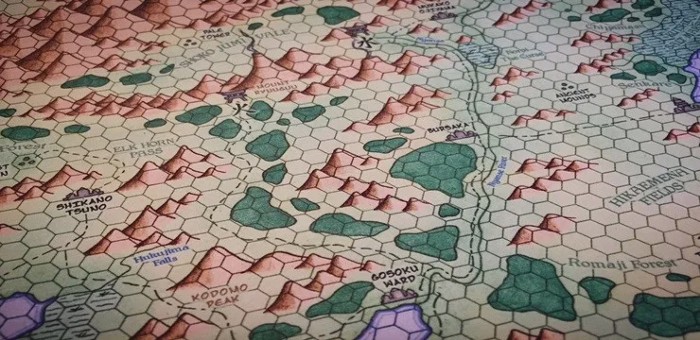
Hello, Adventurers! I'm here to give you a lot of material about this wonderful OSR culture that we love so much. So I'd like to start talking to you about a subject that has been gaining some notoriety again, and I have a huge passion for it, which is the fabulous mechanics and concept of Hexcrawling.
For those who don't know, this concept is older than the very conception of RPG, coming from fantasy literature and wargames, which later became present in the first generations of Dungeons & Dragons, most prominently in the iconic Rules Cyclopedia, from 1991. Although it can be adopted in any system, Old School systems tend to fit better with this style of game. A good example of inspiration is 'The Hobbit' and 'The Lord of the Rings', which are very focused on exploration, survival and travel between different locations.
The most important concepts of a Hexcrawl are basically the following:
-> Hex, our unit of measurement: A Hex is the base unit of measurement. The notion of distance, among several other factors, depends on the Hex. It is usually around 10km long. Embrace randomness: Yes, this mantra of the OSR movement is a very important factor for the structure of a Hexcrawl. The world, the encounters and events are randomly populated. Tables and more Tables: With the help of random tables, we transform randomness into reality, just like life.
-> Exploration of the unknown: One of the greatest attractions of a Hexcrawl is precisely the discovery and exploration of the unknown and the wonders and horrors that the world can offer to players. Exploring and surviving take priority over other aspects of the game. With that said, we can then state that all HexCrawls primarily use the sandbox model (open world). So, now you must have realized why there is synergy between this style of game and Old School RPGs. Their concepts and ideas interact and complement each other, like a nice ham and cheese toast. Well, after getting the general specifics out of the way, we can start to delve deeper into the types of Hexcrawl and how they are played:
->Classic HexCrawl: The classic use of Hexcrawl was in map construction, like in ‘Mystara’ for AD&D, for example, and was used primarily as a metric of distance between locations. Here, HexCrawl is seen almost as a ‘mini-game within the game’, secondary and not completely essential to the functioning of the campaign. Hexploration: Here, HexCrawl mechanics are taken to another level. Exploring the map is essential to the campaign and is the focus of the game. Here we will use several specific rules for hunting, navigating between hexes, among several other actions.
-> West Marches: Although some people say that technically this style is not exactly a hexcrawl, since they do not necessarily use Hex maps to play, I thought it would be interesting to comment here because of some very peculiar and interesting details that could work very well in a Hexploration campaign, for example. In this style, there is usually a base on the borders of the world, where players can recover their strength, but apart from this stronghold, the rest is an inhospitable and absurdly dangerous world, but it is also the place where treasures and adventures are found. An example that includes some of these concepts is the masterful adventure ‘Keep on the BorderLands’, which even has a brilliant version for Old Dragon, called “The Fort of the Borderlands”. Another interesting feature is the fact that several different groups and players play in the same world, not necessarily at the same time. The world exists beyond the players; it is a living and changing entity.
Well, I believe we have enough to start speculating and envisioning how an adventure based on the Hexcrawl mechanics works. In the next topics, we will advance more and more, as if we were entering the dark and deep Forest of Doom, moving on to topics about the creation of these worlds and challenges, so that you can start creating your open world exploration adventures!
I hope to see you soon, in this same Hex! Don't miss the navigation test!
